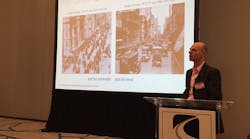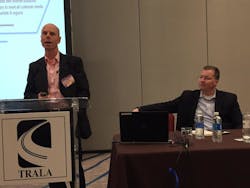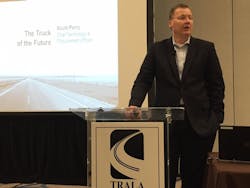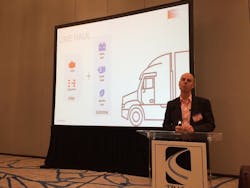BONITA SPRINGS, FL. More change has occurred in the last 20 years than at any time in human history, according to Scott Perry, chief technology and procurement officer for Ryder System Inc., and that lightning-fast pace is being acutely felt in the trucking industry right now, especially in terms of connectivity, the ongoing development of alternative fuels, and the deployment of autonomous vehicle (AV) technology.
“It’s going to be an exciting ride over the next five to 10 years in this industry,” Perry explained during a presentation here at the 2017 Truck Renting and Leasing Association (TRALA) annual meeting.
“At no point ever in our industry’s history have we had this level of connectivity in trucks,” he said. “Our assets are now beginning to talk to each other and to infrastructure. We are developing not just connected vehicles but connected cities and [freight] networks.”
Tim Proctor, executive director of product management & market innovation at Cummins Inc., stressed that those factors are just some of what’s making this “a period of unprecedented disruption and a period of transformational change” within the trucking industry that could ultimately “redefine” the commercial vehicle powertrain for the future.
However, Proctor also noted that while this time period might feel “unprecedented” in terms of the pace of change, similar time periods have occurred in the motorized vehicle space since the dawn of the industrial era.
For example, he pointed to two pictures from New York City – one from 1900 and one from 1913 – that showed how rapidly transportation shifted from one based largely on horses to one based almost entirely on automobiles in just 13 years.
“We know these periods of change have been happening throughout the industrial age,” Proctor emphasized. “What we don’t know is what the ‘tipping point’ is; the point at which we move from today’s technology to that of tomorrow.”
From those perspectives, each laid on near-term and future trends that will impact trucking. Ryder’s Perry went first pointing to what he feels will be major factors affecting the industry:
Cummins’ Proctor focused on how ongoing research into alternative propulsion technologies such as electricity, natural gas, and others, might reshape truck powertrains in the future:
In the linehaul segment, the diesel engine will remain the dominate powertrain for the foreseeable future simply because it offers “really high thermal efficiency” of 42% with the best range, the best fuel density, and the fastest refuel time.Proctor closed his remarks by noting that “regulatory pressures” really only drive improvements to existing architectures. By contrast, the “real” innovations in transportation will come from OEMs and start-up companies.
“When you think about ‘revolutionary technology’ look no farther than Steve Jobs, Apple, and the iPod,” he said. “He not only showed a real understanding of the customer’s issues but then went and solved it in a completely new way.”
In terms of a freight example, Proctor pointed to his work on the new Cummins X15 and X12 family of engines.
“Engines are what the regulators measure so we spent a lot of R&D [research and development] money to improve them,” he explained.
Yet Cummins spent a fraction of that money – “an order of magnitude less,” in Proctor’s words – developing its ADEPT electronic engine control system that is directly helping boost the fuel economy of its new X15 line by 4.5% to 6% versus the older models.
“You are getting more fuel savings with an order of magnitude less spending,” he explained. “That’s where the real innovation is happening and where the disruption will be coming from.”






